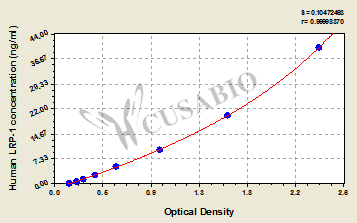This human LRP1 ELISA kit employs the quantitative sandwich enzyme immunoassay technique to measure the levels of human LRP1 in multiple samples, including serum, plasma, cell lysates, or tissue homogenates. It also uses the enzyme-substrate chromogenic reaction to visualize and analyze the analyte levels through the color intensity. The intensity of the colored product is in direct proportion to the LRP1 levels in the sample and is measured at 450 nm through a microplate reader.
LRP1 is involved in two major physiological processes: endocytosis and regulation of signaling pathways, which play an important role in multiple biological activities, including regulation of cell growth and differentiation, modulation of cytoskeletal organization angiogenesis, cell migration, and regulation of protease degradation for tissue invasion. LRP1 mediates the endocytosis of a diverse set of extracellular ligands that play important roles in tumor progression. Additionally, LRP1 can initiate and regulate diverse signaling pathways, including MAPK, insulin receptor (IR), serine/AKT, ERK, and JNK pathways. LRP1 has been postulated to participate in numerous diverse physiological and pathological processes ranging from plasma lipoprotein homeostasis, atherosclerosis, tumor evolution, and fibrinolysis to neuronal regeneration and survival.






